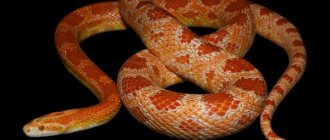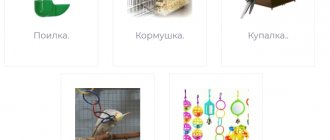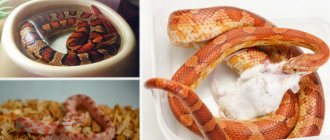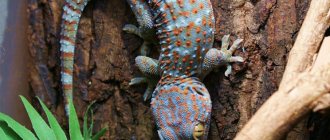Do you know which pet cuddles like a cat, bonds with its owner like a puppy, and loves games more than cats and dogs combined? It's a rat! We are, of course, not talking about infectious pests, but about domestic decorative rats.
If you have already got yourself a pet rat, skip straight to the sections on care and maintenance. If you are just planning a purchase, read the sections about the nature of the rodent (in case it doesn’t suit you) and its choice.
Will you play with me?)
Behavior and character of pet rats
Differences in character in decorative rats are more pronounced than in other domestic animals. If you have several rats, you will see that each of them has its own “personality”. Therefore, it is impossible to predict in advance what temperament your pet will have. But some general lines of behavior can be identified.
Pet rats become attached to their owner. You will quickly notice that the rodent treats family members differently. The rat will choose a “favorite” and will constantly pester him with games and demand affection.
Decorative rats love care and attention. They don’t mind being stroked or scratched at all and easily become tame. Typically, the older a pet rat is, the more it likes to lounge around and enjoy being stroked.
Rats love games. Especially the young ones. In this respect, they resemble kittens - they are ready to endlessly “fight” with your hands, run after objects, climb up your sleeves and in your bosom.
I'm somehow lost...
Pet rats experience emotions and even express them. For example, they are the only mammals (other than humans) that laugh and smile. Try tickling your rat's belly and watch the reaction.
Rats are smart. Their intelligence is so high that simple latches on cages are not a hindrance for them - they quickly learn to open them. They are easy to train and can be taught simple tricks (we will return to training later).
Decorative rats have a good memory. And they remember not only the good, but also the evil done to them.
Rats usually sleep during the day. But if they have someone to “talk” with, then they change their “daily routine” without any problems.
Rats are rodents. In your home, anything that your pet can chew is at risk. And the pet rat itself is also in danger - the wires are chewed very quickly. Therefore, before walking around the apartment, protect your belongings and your pet.
What else would you like to chew on?
Can a decorative rat live alone?
If you can devote enough time to caring for, communicating and playing with a pet rat, then you can get one. Especially if there are children in the house: they will not give the animal rest without reminders. If a decorative rat has to be left unattended for a long time, then it is better to keep several rodents. They must be the same sex (unless you plan to breed them).
Who to choose: boy or girl
Boys become more attached to their owner and learn more easily. But they have a disadvantage: they mark territory, so females are easier to care for. Although pet rats have less odor than most pets, this may not be acceptable for some.
In general, if you keep and care for your rat properly, there will be no problems with odor.
Female or male?
Females are more active, they run, explore the world around them, they will not sit in one place for a long time. Girls are half the size of boys, their fur is softer and smoother. The latter, on the contrary, are twice as large as females, and their fur is hard and oily. Males are much calmer than girls; they can stay on their owner’s shoulder or arms for a long time. Their only drawback is their natural instinct to mark everything around them.
You should not keep young animals of different sexes in the same cage, especially from the same family (young brothers and sisters); such mating can lead to the death of the female or poor offspring.
What does a pet rat need?
Before purchasing a pet, buy everything you need to keep and care for a decorative rat. This:
- Place of detention (cage, dune, aquarium)
- Utensils for food
- Drinking bowl
- small house
- Filler (litter)
- Tray/toilet (optional)
Let's look at each point in more detail.
Which accommodation to choose
In many ways, the question of choosing housing is a matter of personal tastes, capabilities and free space in the apartment. However, each option has its own advantages and disadvantages.
Rat cage
Housing suitable for keeping pet rats: durable, practical and easy to care for. But only if you choose the right option. Let's pay attention to the most important details.
Size. For a cage in which one rat will live, a bottom size of 60x40 cm or more is recommended. But the cage can be either a single-level or a three-story palace with an entire amusement park for a decorative rat. In the second case, 2-3 individuals can live in a cage with the same size base.
Material. The rods must be metal (the distance between the rods is no more than 12 mm). The pallet is plastic. Wooden ones will be chewed, and it also gets wet (when domestic rats mark the territory) and absorbs the smell of urine, which cannot be removed later.
Design. Take one with a removable tray (that’s how they make it now, but suddenly you come across a non-removable one). This makes caring for the cage very easy.
Locking mechanism. Your decorative rat will quickly get the hang of opening a simple lock, so you need something more complicated (with a fuse, for example) or with a door in the roof.
Simple and “advanced” cells.
Dune
A good option made from solid plastic (the top part is transparent). But we do not recommend keeping more than one rat in such a house: ventilation is not ideal (air flow is only from above) and the dunes are mostly single-level - it can be a bit cramped. Of course, you can take a large dune, but not everyone has that much free space at home.
There are also hybrids of cells with dunes. Typically, in such models, a block of rods is inserted between the top cover and the tray. This increases (for several levels) and solves the issue of ventilation. Such cages for a decorative rat can cost less than a regular cage. The whole variety of cages, dunes and their hybrids for keeping rodents is presented here.
Examples of dunes and "cage dunes".
Alternative housing
Let's immediately reject completely unsuitable options for keeping pet rats - jars, boxes and other improvised materials. They are either too cramped and there is no air circulation, or the material is unsuitable (the cardboard will simply get wet).
An aquarium is more suitable for keeping, but ventilation must be provided. Due to poor oxygen flow, carbon dioxide can accumulate in it, which will first lead to lethargy and then to irreversible changes in the brain. If the aquarium is very cramped and narrow (and many also close it with a tight lid), then the domestic rat may die. In addition, caring for an aquarium is not very convenient.
Select an aquarium with a minimum bottom size of 60x40 cm (this is for one rat, for a pair you need one and a half times more). You can have a more elongated shape, but so that the area remains approximately the same.
Utensils for food
We place dishes that cannot be chewed. If you choose metal, the main thing is that there is no enamel on it. Ideally, it would be good if the bowl can be secured to the bars of the cage - it makes cleaning the house easier and there is less chance that food will be scattered all over the tray.
Drinking bowl
There are a lot of options here: from a simple bowl to advanced modern devices. The best option for rodents is a nipple drinker. Just be sure to have a metal nipple so that it doesn’t get chewed off.
Change the water every day, regardless of whether you drink it or not. Drinkers designed specifically for rodents can be viewed here.
Cozy mink
Place a small house in the cage where the decorative rat will hide from annoying attention. You can use a jar or flower pot placed on its side. Place stuffing or soft cloths inside.
If funds allow, buy a ready-made house. Nowadays there is a huge selection of beautiful houses in stores (houses with a terrace or in the shape of fruit). There are also very functional options that save space and make maintenance easier (for example, a house with a ladder to a feeding trough on the roof and with an attached drinking bowl). But it's better to see once, so look here.
Oh, guests!
Toilet
Not all breeders install a litter tray; many find it easier to change the litter in the cage. This is especially true if there are a lot of domestic rats and it was not possible to train them all to the tray.
If you keep 1-2 decorative rats, then using a tray may be more convenient - there will be less general cleaning and litter consumption. To make it easier to accustom rats to one place, wait until they themselves determine the place for the toilet, and then place the tray there (also add a little of the litter your pets have already used to the clean litter, so that the smell is familiar).
Filling or bedding in the cage
Decorative rats are clean pets, and they choose only one place for the toilet - away from food and the house. If you choose a filler, you can replace it gradually (only the dirty corner).
Only change the entire litter. If you choose bedding, then you need to install a tray and train your pet rats to it. You can try both options and decide which is easier for you to take care of your home.
Unfortunately, it is impossible to say unequivocally which filler is better. Not only do each have its own advantages and disadvantages, but rats also react differently. You may have to try several options before your pet rat feels comfortable.
General recommendations for selection
Do not use filler that is too fine (close to dust). For example, small sawdust. They will get into the pet rat's respiratory tract and eyes, and are not very convenient to care for.
Remember also this dependence: the older the decorative rat, the more difficult it is for it to move on large, hard pieces. Therefore, hard granules and wood chips are not suitable for keeping elderly rats. This also applies to overweight pet rats with pododermatitis. Give them softer litter or use disposable bedding.
Let's look at the most common varieties with their pros and cons.
Organic
Vegetable fillers are made from grass, flax, and hemp. But the most popular is corn. It absorbs well, holds odors, is hypoallergenic, and edible. Minus: it is quite noisy (if a cage with pet rats is in the bedroom, it will interfere).
Woody
When it comes to wood fillers, choose materials only from deciduous wood (coniferous ones can cause irritation of the mucous membranes and breathing problems in decorative rats). The tree is less noisy than corn. Odor retention depends on the type of wood.
Paper
You can lay down paper from homemade paper stock or buy ready-made “pellets”. But paper hardly holds moisture, quickly gets wet and is simply destroyed by domestic rats. Therefore, you need to change it often (2-3 times a day).
It is considered cheap, but you cannot use paper with printing ink or sharp edges (such as office paper). All that's left is paper towels and napkins, but if you change them twice a day, it's not that profitable.
Conclusion: caring for paper bedding takes time and a lot of money. Suitable as a temporary option until you get wood or plant filler. You can select them on this page.
Breeds of decorative rats
Let's take a look at the main varieties of pet rats to make it easier for you to choose. Decorative rats are divided into:
- By physique
- By wool type
- By color
Division by body type
rats . The name was given because of its resemblance to Disney's baby elephant Dumbo, who could fly by waving his huge ears. Dumbo the rat's ears aren't that big, but they stand out. Rounded, sticking out more to the sides than to the top, like the others.
What are you watching? Quite an average size!
Standard . There’s nothing even to add to the name of the breed – a standard rat.
Standard? Sounds like an insult.
Tailless . An ordinary house rat, but without a tail.
Classification by coat type
Rex . Pets with beautiful curls.
Rex.
Satin (Satin, Longhair) . Thin, soft fur, which, when properly cared for, shimmers in the rays of light.
Satin Dumbo.
Sphinx (hairless) . Has a little “vegetation” on the head and back. An excellent choice for those who are allergic to wool.
Sphinx Dumbo. Well, aren't I adorable?
Downy (Fuzz) . They are distinguished by short and fine downy fur.
Down jacket.
Types of colors
Nowadays it is difficult to find a color that has not yet been developed by breeders. But there are also those that stand out from the general background.
Blue domestic rat. A very interesting shade of fur that needs to be seen in person (not every screen captures this color correctly).
Husky . The coloring is similar to that of dogs of the same breed.
Decorative white rat. People often look for a white rat with red eyes. The eyes are red because blood vessels are visible through them (in albino rats, not only the fur is discolored, but also the eye pigment).
Let's go choose
Buy pet rats only from those you can trust. This can be either personal acquaintances or someone’s recommendations and reviews on the Internet about breeders/shops. Also form your own opinion when viewing: in what conditions are decorative rats kept, how the owner cares for rodents and treats them. Even by the way the seller takes and holds the rat (carefully or roughly) one can understand how he kept it.
What to look for when purchasing?
- When you put your finger near the cage, a healthy, inquisitive pet will run up and sniff.
- Observe a little how the animal behaves: actively plays, hides, lies or fights. Most likely, he will remain so.
- Carefully inspect your pet rat for damage and skin diseases. The coat must also be healthy.
- The eyes should not be festering/watery.
What determines the lifespan of a rodent?
An inexperienced breeder may cross-breed sick animals and pass on undesirable traits to the baby rat, such as an inherited health condition, along with a certain color or coat pattern.
The optimal age for purchasing pet rats is about 6 weeks. Look for a healthy rat with shiny fur and lively eyes. Healthy rodents should also be active and inquisitive.
The rat you choose should not be sneezing, have a runny nose or red eyes. And you should make sure that the rat's droppings are dark and hard.
Rat nutrition throughout life.
A rich diet for your pet rat is a guarantee of a long and happy life. Make sure she eats food specifically made for rats, and be aware of which human foods are safe to eat as rodent treats and which are toxic.
What to feed a decorative rat
Rats are often used for laboratory research, and the data collected suggests that the life expectancy of a pet depends on the quality of feeding. Much more than the quality of care and living conditions. If you feed table scraps exclusively with treats, then a domestic rat is unlikely to live longer than a wild rat - this is about 1 year. With proper nutrition, this period can be increased to an average of 3 years.
What can you give to your pet rat?
A healthy diet for a decorative rat is distributed approximately as follows:
- 60-70% cereals
- 10-20% succulent food (fresh vegetables and herbs)
- About 10% fruits and berries
- 1-2 times a week animal protein
- Treats in small quantities
Let's look at each point in more detail.
Cereals
The following options are preferred:
- Wheat
- Barley
- Pearl barley
- Rye
- Millet
- Rice
Usually they take 3-4 types of grains and mix them.
Vegetables and greens
Vegetables and herbs are necessary for a pet rat to receive vitamins and microelements. But don’t get carried away with “healthy eating”: diarrhea is possible. Good selection of vegetables and herbs:
- Carrot
- Boiled zucchini
- Cucumber
- Celery
- Salad
- Dill
- Dandelion
Fruits and berries
Recommendation for fruits and berries:
- Apple
- Strawberry
- Raspberries
- Currant
- Cherries
- Cherry
Animal protein
1-2 times a week you need to add a little animal protein to the diet of your decorative rat. Suitable for this (all boiled):
- Chicken breast
- Egg white
- Shrimps
- Lean fish
- Lean red meat
- Low-fat fermented milk products
Treats
Sometimes you can pamper your pet rat with treats (or use it as a reward during training). The main thing here is not to overdo it - just like for humans, treats are rarely beneficial for the health of pets.
To please your rodent, you can offer him:
- Berries and fruits from the list of permitted
- Baby puree
- Nuts and seeds
- Ready-made store-bought products (cereal sticks and rodent cookies)
Ready-made feed
If you don’t have time to prepare a grain mixture, buy ready-to-eat food in the store. In addition to grains, the set most often already includes vegetables and herbs, but this is not a complete replacement for fresh produce. It may also contain dried meat. It is desirable that the feed contains less than 10% fat.
What is not suitable for feeding
List of prohibited products. They should not be given to a pet rat, even as a treat.
- Fatty meat and fish
- Full-fat dairy products (eg sour cream, cream)
- Sausage
- Raw potatoes and zucchini (lots of starch)
- Cabbage (it makes you “swell”)
- Legumes (also bloating; eg beans and peas)
- Tropical fruits (lots of acids that are dangerous for the animal)
- Fried, smoked, dried, pickled
- Food seasoned with spices
- Bakery
- Candies
- Alcohol
- Soda
- Mushrooms
You can't eat this.
Give with caution
This category can include almost everything that is not included in the list of permitted and prohibited. Let's just dwell on a couple of points.
Nuts and seeds. It is necessary to greatly limit it, because... they have a lot of fat, and decorative rats quickly gain excess weight.
Dried fruits. It's not quite the same as fresh dried ones. Sugar is added to them, and this is harmful for the domestic rat.
Bananas. Unlike other tropical fruits, they can sometimes be given, but only when fully ripe. Greens are by no means allowed.
When to feed your rat
It is customary to pour food 2 times a day - morning and evening. In the evening they give a little more, because... The rodent is nocturnal. If your pet rat does not eat everything at once, you should not immediately change its diet. She will first choose what is tastier, and then she will move on to the rest.
You shouldn’t hope that “the rat won’t eat too much” and won’t overeat. Most often, domestic rats eat everything they give, and also try to steal away what is lying badly. Don't keep adding food endlessly; feed in moderation. Start from the figure of approximately 30 g of food per day for an adult pet.
Monitor whether your decorative rat is losing weight or gaining weight, and adjust the portion size.
Diet
Domestic ornamental rats are omnivorous. But here too there are some peculiarities.
The rodent should be given the following products:
- Grain mixture, which can be purchased at a pet store.
- Plant food. Rats can be given carrots, tomatoes, boiled potatoes (raw ones cannot be given), bananas, apples, citrus fruits, dandelion, coriander, dill, parsley. But owners must introduce a new product into the diet, as the rodent may experience an allergic reaction.
- Protein food. This can be boiled meat and dairy products. They should not be given every day and little by little.
In order not to harm the pet when purchasing certain treats, owners need to carefully read the ingredients.
The following should not be introduced into the diet of rodents:
- sweets;
- raw legumes;
- red and Brussels sprouts;
- smoked meats;
- chips,
- carbonated drinks and sweet juices;
- Almost all houseplants and garden plants can be poisonous to rodents, so if in doubt, do not give them to your rat.
Sometimes owners give their pet alcoholic drinks for fun; as a result, the animal quickly gets used to alcohol and can no longer do without another dose.
Taming and training
Usually domestic rats are friendly by nature, but if your pet doesn’t want to come into your arms right away, don’t be upset and be patient – very soon he will become tame.
To start, try giving treats by hand. Once the rodent gets used to your smell and understands that you do not pose a threat, he will begin to eat from your hand without fear. Then start stroking the animal a little while feeding. And only then (if there is no negative reaction from the decorative rat) try to pick it up.
When training, also reward your pet rat with treats. This way you can teach him to respond to a nickname (call him and give him a treat, then try to increase the distance) or to stand on his hind legs (hold the treats higher and say the command).
Never scold or hit a rodent!
Is it possible to bathe a rat?
You can bathe your pet rat. But is this really necessary? Rats even take care of themselves at home. Decorative rodents are not afraid of water, but this does not mean that they like to swim. Some people really like this procedure, but this is rather the exception.
It is necessary to wash a pet rat only if it is very dirty and cannot wash itself (for example, it got into something or is sick). Dip your pet in warm water (just don’t submerge your head). If you use shampoo, be careful not to get it into your mouth, eyes, or ears. Afterwards, dry it well, or better yet, hold it on your hands in a towel until it dries.
In other cases, the decorative rat will handle its own coat care. Bathing is usually more trouble than it's worth. For example:
- Rodents are prone to respiratory diseases; the risk of getting sick after a bath increases
- Sometimes otitis media occurs from water in the ears (not every domestic rat will sit quietly and endure while they are washed, especially if it is not yet tame)
- Grooming with detergents that are not suitable for pet rats can lead to skin and coat problems
- A pet that smells of soap may be poorly received by other animals (they will not recognize the smell)
- Psychological trauma is possible if a decorative rat is forcibly bathed
If you really can’t do without washing, try using wet wipes – most often they help.
Wipe dry, do not leave wet wool.
It can be gigantic
An ordinary person understands a rat as the most common species on the planet - the Norwegian, or gray (Pasyuka), and its domesticated relative, which is bred in homes.
There are legends that these creatures grow almost to the size of a cat. This is not true - pasyuki do not grow. The largest of them rarely reach 50 centimeters including the tail and gain 450 grams.
But... In nature, there is not only this type of rat. In New Guinea, during the filming of a BBC nature film in 2009, a completely new species was discovered in the crater of the Bosavi volcano.
It was named the Bosavi woolly rat. This miracle of nature reaches 82 centimeters (including the tail). This “rat” weighs about 1.4 kg. And she is not at all afraid of a person whom she has never seen during her volcanic life.
Rat. visualhunt.com
Common diseases of ornamental rats
The most important thing: if symptoms of any disease appear, incomprehensible behavior (lethargy or, on the contrary, hyperactivity), or refusal of food or water, immediately contact a veterinarian.
Self-treatment or inaction can be fatal for a pet rat.
Obesity
This is usually the result of the “the rat knows how much it eats” fallacy. Unfortunately, most often she doesn’t know, and she gains weight very quickly. Excess fat brings with it a whole chain of other diseases: problems with the gastrointestinal tract and cardiovascular system, diseases of the musculoskeletal system. A ratologist (a veterinarian for rodents) will create a diet for losing weight for a pet rat and adjust the conditions of detention.
Pododermatitis
Wounds and calluses on the paws are a common result of excess weight. Before visiting the veterinarian, make life easier for your pet: replace the hard coarse litter with small soft litter or disposable litter.
Skin diseases
If scratching, bald spots, or ulcers appear, do not use medications at random or according to recommendations. The reasons for these phenomena can be radically different things:
- A pet rat has injured itself (for example, as a result of fright or stress)
- Dermatitis
- Parasites
Therefore, just go to the clinic, otherwise it may get worse (for example, when using an anti-parasite spray for a skin disease).
Parasites
They are rare. At risk are those decorative rats that are kept in the same house with animals walking on the street - cats and dogs. Only a specialist can determine the type of parasites and the correct treatment.
Respiratory diseases
If your pet rat sneezes (constantly, not once or twice), you need to go for an examination. There they will determine what it is: just irritants (such as small filler) or something serious. Upper respiratory tract infections develop very quickly in pet rats, and pneumonia and abscesses are often detected.
Tumors
One of the few diseases that we practically cannot influence with care, living conditions and nutrition. Without tests and consultation with a veterinarian, it is impossible to find out what kind of bump a decorative rat has.
How can a person be infected?
Of the diseases that are transmitted to humans, the most common are certain types of lichen. But with proper care and hygiene (both rodent and personal), these problems will bypass you.
Reproduction
Rats reach sexual maturity after 6 months; if there are two individuals of different sexes, you can start breeding rodents. These animals are highly fertile; the female's estrus repeats every 10 days.
Mating of rats occurs within 1-3 hours, and pregnancy lasts 21 days. It is important to provide the pregnant female with plenty of vegetables and fruits, which contain the necessary vitamins. Before giving birth, the female arranges the nest, carrying into it various materials available to her, from paper to rags.
On average, the litter is up to 8 rat pups, each of which weighs barely 7 grams. After giving birth, the female and her cubs should be separated from other individuals. Feeding newborns with mother's milk lasts about a month, after which the babies try adult food.
Rats are born naked, fur appears on the animals by the 10th day, and the opening of the eyes occurs 2 weeks after birth. Baby rats acquire complete independence at the age of one and a half months.











